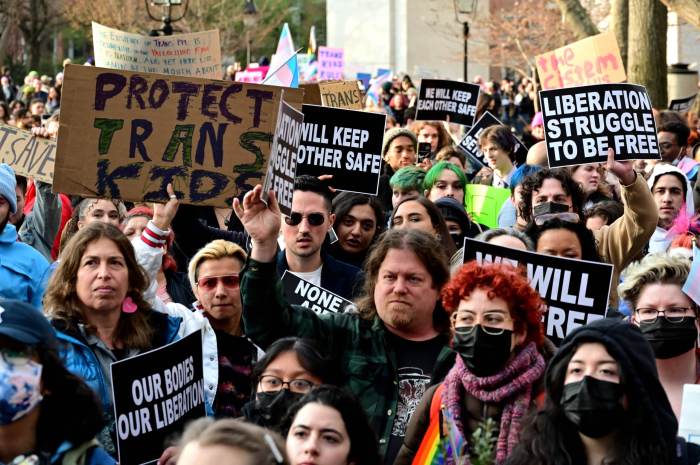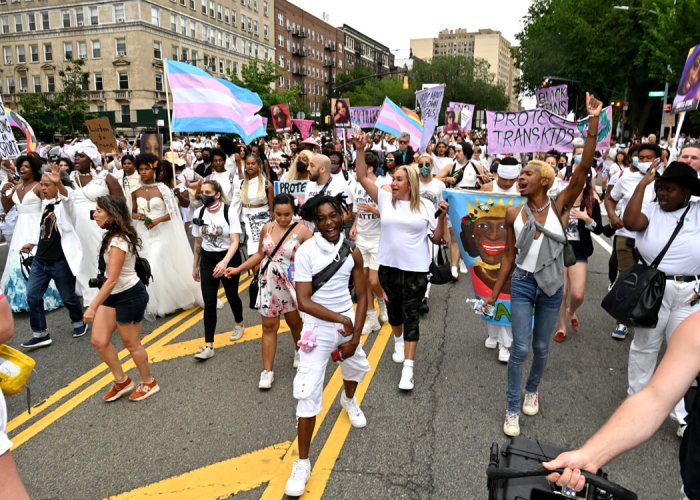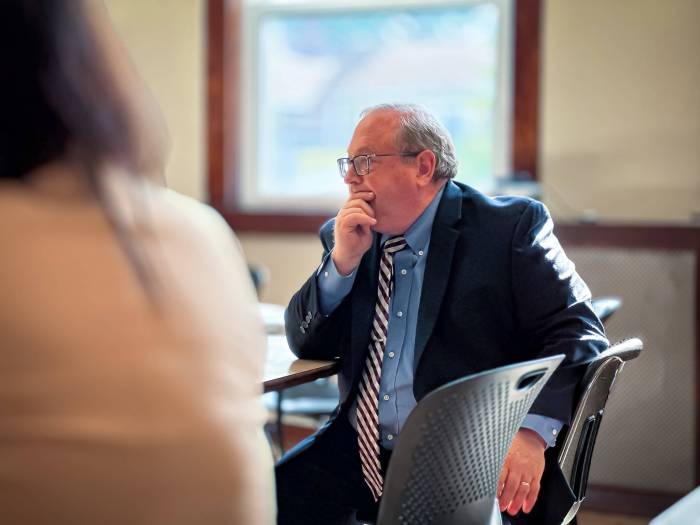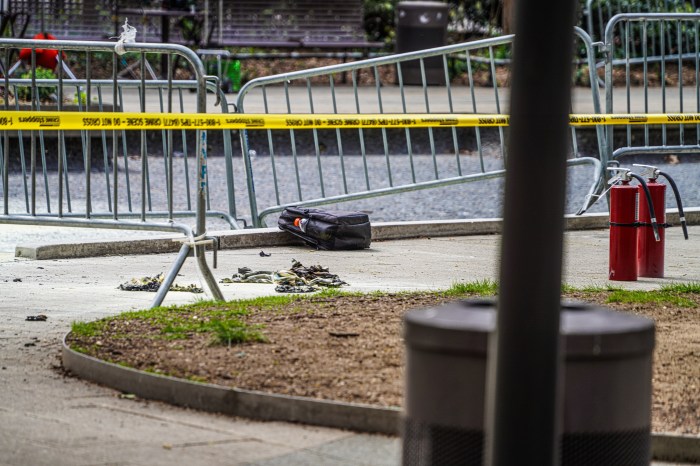“I don’t know if we get another one like this again.”
With a tone best described as triumphant wonderment, those are the words New York Governor Andrew Cuomo chose to begin his account of how he led the state’s leading marriage equality advocates to victory on June 24.
In an interview with Gay City News four days after that win, the governor said, “Let’s face it, this was a long shot,” when asked where his confidence in winning the battle during his first six months in office came from.
“I didn’t have confidence,” Cuomo continued. “I had commitment to make the effort to get this done.”
After four years as attorney general, a stint of the same duration as Bill Clinton’s housing secretary, and an ongoing role more than two decades ago as a key advisor to his father, the former governor, Cuomo has demonstrated an assertive style as New York’s chief executive, and his acknowledgment of just how uncertain success was last week in the State Senate was striking.
“I was always cautious,” he explained. “I never used the words… I never said, ‘I will definitely get this done.’ I was anxious about raising expectations.”
Regardless of the governor’s intentions, gay and lesbian New Yorkers’ expectations were very high. Efforts by the community last year helped deny three senators who had voted against marriage equality in 2009 the chance to remain in office –– Queens Democrat Hiram Monserrate, in a special election in March; Buffalo Democrat William Stachowski, in the September primary, and Queens Republican Frank Padavan, in November.
Cuomo, elected in a landslide in November, enjoys approval ratings undiminished by the scramble to enact an April 1 state budget, a process that traditionally tarnishes everyone in Albany.
And, at several key points, the governor upped the ante on his public commitment, most dramatically when the budget was signed and he indicated marriage equality was one of his three top priorities for the remaining days before the Legislature’s late June adjournment.
There were good reasons, then, for the gay and lesbian community to expect that the governor, by leveraging his political capital, would get the job done on marriage equality. At moments during the final two weeks of the campaign, that effort, in Cuomo’s telling, hinged very much not only on finding the critical 32nd vote needed for a Senate majority, but also in firming up a 33rd vote.
On June 13 and 14, Cuomo and the advocates rolled out three additional Democrats –– bringing the number of yes votes in that conference to 29 out of 30 –– and two of the 32 Republicans, increasing the tally to within one of clinching victory.
“It stopped at 31,” the governor said of the roll toward success that, at least in public, stalled for the next ten days. “The 32nd vote, that person would have become the poster child for passage.”
Cuomo –– and presumably the other advocates as well –– became convinced that at least two more votes were needed to ensure the right outcome; neither of those last two could later be said to have played the decisive role.
Meanwhile, when the Republican conference first discussed the bill in detail in a four-hour meeting on June 15 but put off any decision, complaints about the impact marriage equality legislation would have on religious institutions emerged as the critical stumbling block to progress. Three GOP senators –– Stephen Saland of Poughkeepsie, Andrew Lanza of Staten Island, and Kemp Hannon of Long Island –– were deputized to negotiate with the governor on those issues. According to others close to the pro-equality effort, the three also found themselves going back to their conference numerous times to vet ideas from Cuomo.
In the end, Saland was the only one of the three negotiators to vote for the bill, and according to Cuomo, “he was exactly the right person” to sit across the table from the governor in what proved to be numerous rounds of discussions.
“He focused on all on the facts,” the governor said of Saland. “He is cerebral, deliberate, and non-emotional.” The floor speech the Poughkeepsie Republican gave on June 24 explaining the religious exemption language agreed upon “was reflective” of his personality as a legislator and negotiator, Cuomo said.
At some point, the governor became convinced he could secure the support of the two additional Republicans who wound up providing the 32nd and 33rd votes –– Saland and Buffalo freshman Mark Grisanti. The deal seemed just about set until “Grisanti says he’s not sure.”
At this point in his retelling, Cuomo acknowledged that his sense of negotiating decorum might have ended the hopes of getting marriage equality done.
“I gotta go back to Saland,” he recalled. “I told him, ‘I am relieving you of your commitment because I cannot deliver on my commitment.’ He took a beat, frankly, and then came back and said, ‘I am willing to do it even if I’m 32.’”
Without assurance of a buffer vote, then, the advocates were still assured of victory –– though Grisanti eventually voted yes as well. “True courage,” the governor said of Saland. He and Grisanti, Cuomo noted, “did things that were not politic.”
The governor also had praise for the “gutsy” stance taken by the five senators who preceded Saland in coming on board –– Democrats Joe Addabbo and Shirley Huntley of Queens and Carl Kruger of Brooklyn, and Republicans James Alesi of Rochester and Roy McDonald of Troy. When they committed on June 13 and 14, Cuomo conceded, it was not clear the votes were there.
“The word was trust,” he explained. “They said, ‘I’ll come out the day of the vote.’ And I said, ‘No, I need you to come out early. Don’t worry. We’re walking down the field, we’ll get to the end zone. I’m not exactly sure how we’ll get there, but we’ll get to the end zone.’”
That was the moment Cuomo and the advocates had to commit to going forward with a Senate vote. A month earlier, the governor had startled some marriage equality supporters and confused some in the media by saying he would not seek a vote without assurance of victory. Several activists accused him of backtracking, but one person with direct knowledge of the governor’s thinking countered this view, explaining that it was about maintaining control of the process. In 2009, as this perspective goes, the effort broke down when, first, Governor David Paterson and, later, the Senate Democratic leadership committed — well in advance of securing sufficient commitments — to the posture that the bill would go to the floor.
Cuomo took a gamble, but one not nearly as big as the bet in 2009, when he decided to move forward. It had become a chicken and egg question in the end.
“You needed to commit,” he explained. “Once you asked anyone to commit, you had to go forward. I didn’t have 32. I believed I would get 32, but it was very gutsy for Huntley, Kruger, and Addabbo to step forward. And Alesi and McDonald.”
The Senate’s GOP leadership, the governor said, wanted to avoid having to make a decision on allowing a floor vote, “so I believed that it was always about removing the barriers. So, first, the response from the Republicans was ‘You don’t have the Democrats.’ Then we had the 29 Democrats” –– all but the Bronx’s Ruben Diaz, an implacable foe of LGBT rights.
“Then we had Alesi. Then we had McDonald, and it was truly bipartisan.”
As other advocates in the fight told Gay City News, the struggle was not over yet; winning agreement from the Republican conference to allow the 33 marriage equality supporters the opportunity to cast their yes votes on June 24 remained a nail-biter up until that morning.
But, on the key religious language compromise that enabled Saland and Grisanti to sign on to the bill, the governor was steadfast in his comments this week.
“I was comfortable, and, by the way, I ran it through the group,” he said of the team of advocates his office had been working with for months. “We went through every comma.”
The New York Times and a number of online bloggers have raised questions about whether the compromise amounts to an infringement on the existing civil rights enjoyed by the lesbian and gay community, but a variety of voices, from Daniel O’Donnell, the law’s lead sponsor in the Assembly, to Donna Lieberman, executive director of the New York Civil Liberties Union, argued to Gay City News that nothing in the language curtails any existing protections based on sexual orientation or expands exemptions available to religious groups beyond what are already in law.
Separate from the interview with Cuomo, the governor’s office declined to respond to hypothetical questions about the exemptions language, but Lieberman said she saw nothing there that would not pass “constitutional scrutiny.” As a result, she said, the NYCLU has no concerns about the bill’s “non-severability” language that would invalidate the entire law if any part were struck down in court.
“There is no reason to look back,” Lieberman said. “This is a victory for us.”
Ruthann Robson, a University Distinguished Professor at City University of New York who specializes in constitutional law and family law, concurred with Lieberman’s assessment that there was nothing new in the language incorporated into the marriage equality law.
“Given the fact that there wasn’t anything public about the language beforehand, I thought that it might be much broader,” she said. “It looks to me that it doesn’t go any further than what was already there.”
Leonard G. Florescue, who teaches at Fordham Law School and writes about the state’s domestic relations law at the New York Law Journal, said he was “not terribly concerned” about the religious exemptions, noting they were more suited to “theoretical law school exercises rather than anything with real impact.”
In his response to questions about the exemptions issue, Cuomo added, “I will say, gratuitously, that it’s a trap for the gay community. There is no reason for the gay community to alienate the religious community.”
In raising that caution, Cuomo was clearly not referring to any missteps he encountered in the work with the advocacy groups his office had marshaled for months. Of that coalition –– which included the Empire State Pride Agenda, the Human Rights Campaign, Freedom to Marry, the Log Cabin Republicans, Marriage Equality New York, and the Gill Action Fund –– the governor said, “The unity was extraordinary. These were extraordinary people who put their egos aside and were unified to get the job done.” He specifically mentioned the efforts of ESPA’s Ross Levi, HRC’s Brian Ellner, Emily Giske, a government affairs specialist at Bolton-St. Johns, and the Gill team.
As he did the night the bill was passed, the governor spoke in detail this week about the “power” of New York’s example in enlivening the marriage equality push nationwide. Asked if in five years, other states will wonder why they too hadn’t moved forward in 2011, he responded, “Yes, but it won’t take five years.” Then, referring to the standing advocates already have to press the issue elsewhere, he said, “It has become a legitimate issue, even a litmus test.”
The night before the June 24 vote, President Barack Obama spoke to an LGBT audience in New York, but declined to take a position on the legislation. Asked how Obama should respond to the question that is now “legitimate,” Cuomo at first joked, “He could have said, ‘Hey, you haven’t even passed the bill yet,” but then added, “That’s a political call for the president to make.”


































